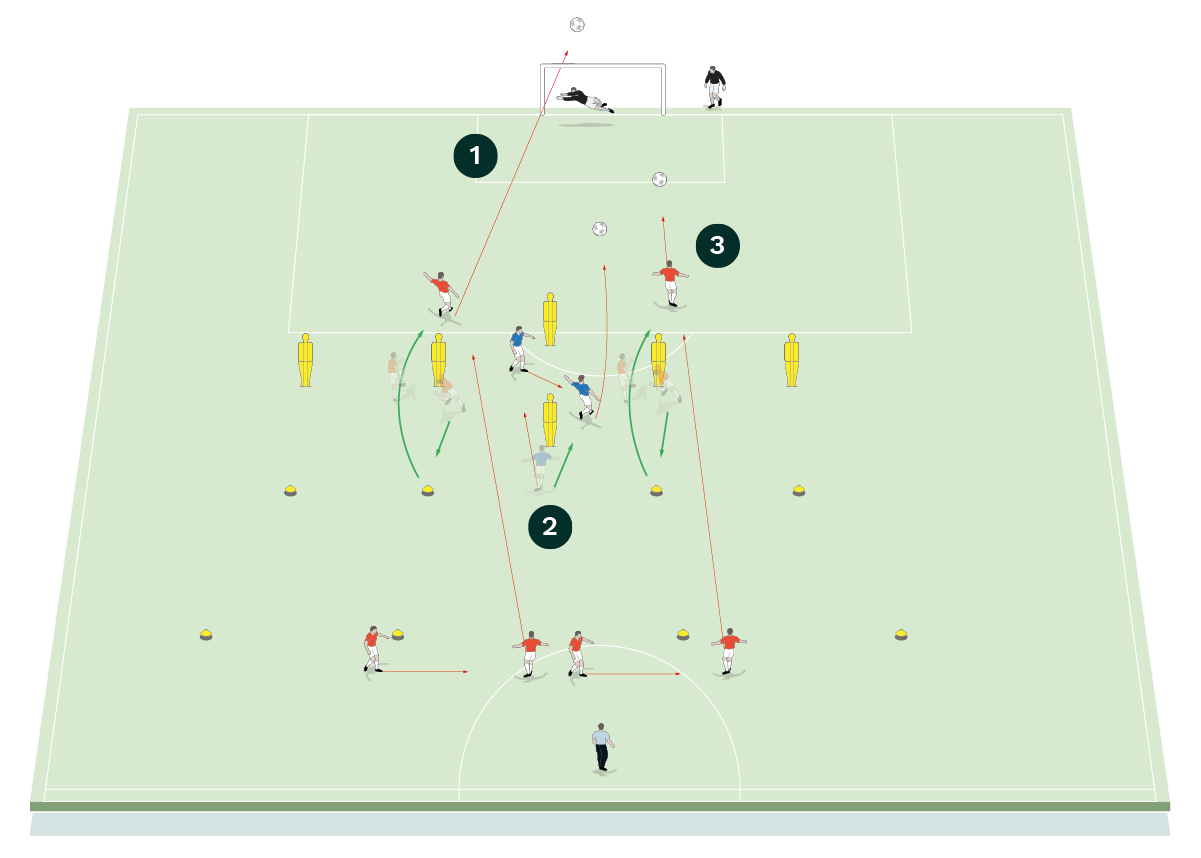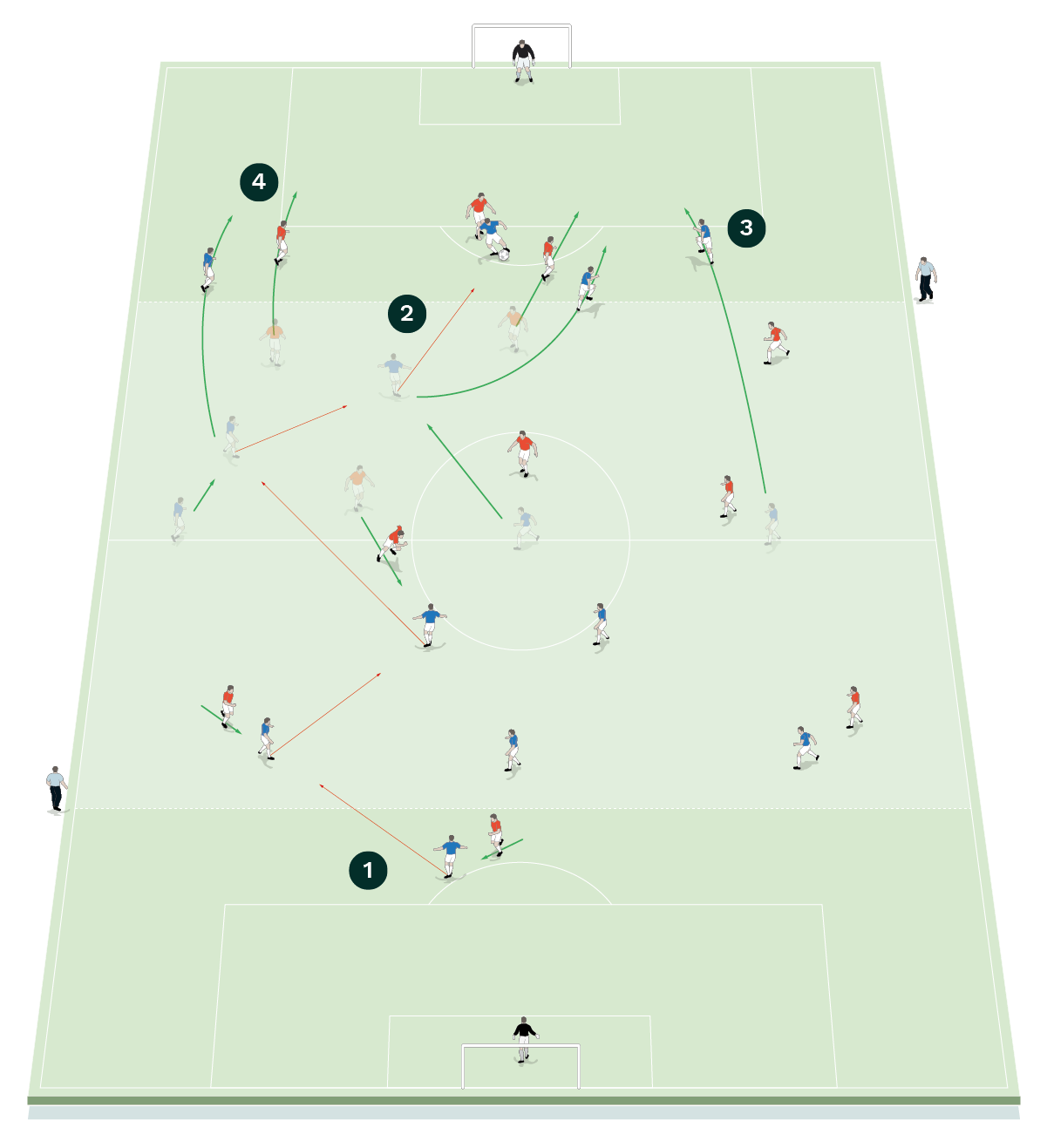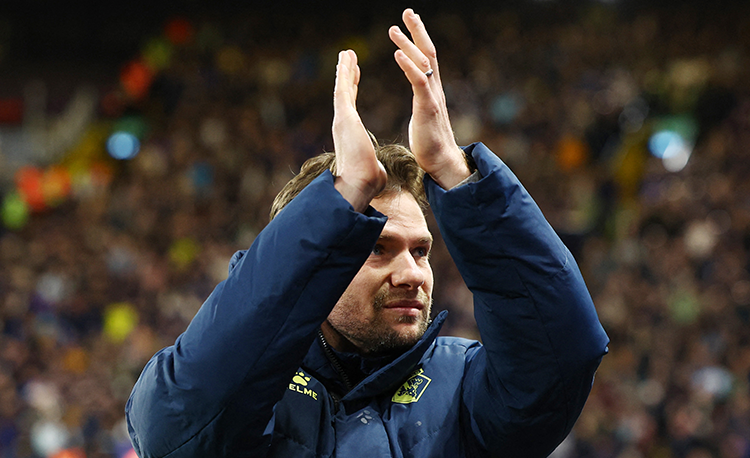
| Area | Up to full pitch |
| Equipment | Balls, bibs, cones, 1 rugby pad, 7 mannequins, 2 full size goals |
| No. of Players | Up to 20 players + 2 goalkeepers |
| Session Time | Technical practice: 15mins Crossing and finishing: 10mins Attack versus defence: 10mins 11v11 game: 20mins |
This session is about attacking with purpose and quality. It focuses on developing good combination play between attacking players and provides realistic challenges for attackers and defenders to prepare for match scenarios.
Players always enjoy this session as it creates plenty of opportunities to score goals. It starts unopposed and builds into an opposed session for realism. We also introduce a sense of competition to make it interesting, and to succeed at this session players need to be ruthless and clinical in front of goal.
In an ideal world we would run this on match day -3, as a technical session.
We would run this sort of session once, or possibly twice, a week.
“Players always enjoy this session as it creates plenty of opportunities to score goals”
TECHNICAL PRACTICE
We set up on half a pitch with a goal and a goalkeeper at one end. We place six mannequins as shown and mark out two rows of flat discs, the first row five yards from the mannequins. This creates three stations: one on the left hand side, one on the right hand side, and a central station using the two mannequins lined vertically in the middle. The stations are slightly off centre.
We’re using eight outfield players split into six red forwards or strikers and two blue midfielders. Three red forwards are on each of the first and third stations – one forward at each of the two flat discs in the row furthest from the goal, and the other forward in front of the end mannequin on each side.
Two blue midfielders are on the middle station, each positioned in front of a mannequin. The objective for the players of each station is to run through their attacking combination and take a shot on goal. The stations run in order, one at a time from left to right.
[1a]

- The stations go in order from left to right. Station 1 starts first with a pass between two reds and then a through ball is played to the attacker nearest the goal
- The coach feeds a pass through to one of the blues to launch an attack from station 2
- On station 3, the attack starts with a pass between two of the red attackers
- The objective for the players of each station is to run through the attacking combination as shown and take a shot at goal
[1b]

- To progress the drill, the players go again but this time they are narrower and are positioned slightly more centrally, encouraging shots from a more central position
- On the second station, this time the coach is no longer involved and play starts from one of the blue midfielders
- The attacks from each station should still end with a shot on goal
On the first station, the player furthest to the left plays the ball to the player to their right. The player furthest forward drops to their closest flat marker, then changes direction and sprints on the outside of the mannequin into the penalty area where they receive an inside pass and take a shot on goal.
On the second station, the coach feeds the closest midfielder the ball. They receive it on the half turn and play the ball to the midfielder in front of them, then make a run beyond the mannequin where they receive a return pass and shoot.
On the third station, the player furthest to the left passes the ball to the player to their right. The player furthest forward makes a run to their closest flat marker, then changes direction and sprints on the inside of the mannequin and into the penalty area. They then receive an outside pass and take a shot at goal, as shown [1a].
The players reset and the drill starts again. To vary attacks, on the first and third stations the ball can start from the player furthest to the right and alternate from using an inside pass to an outside pass, or vice versa.
To progress the drill, we run it again, but this time the players are narrower and are positioned more centrally, allowing for shots from a central position. On the second station, the coach is no longer involved and play starts from one of the forwards, as shown [1b].
CROSSING AND FINISHING
We set up on half a pitch with a full size goal and a goalkeeper on each side of the penalty area. Seven mannequins are set up in front of the penalty box and a coach is positioned, as shown, holding a rugby pad.
We’re using five outfield players, positioned as shown. The players begin by running an attacking drill down the left hand side of the pitch.
The first phase involves three strikers – one positioned towards the halfway line, one starting out wide and one near to the coach with the rugby pad.
Play starts with the striker nearest the halfway line passing to the striker furthest forward. The higher striker drops to receive the ball under pressure from the coach and plays it directly back, before spinning to make a run around the mannequins. The striker near the halfway line receives the pass back and plays the ball to the wide attacker, who passes for the furthest forward striker to run onto and take a shot.
The second phase of the practice then starts, this time involving the two midfielders in the middle and the striker furthest forward. The deepest midfielder receives a ball from their team mate and plays it straight back before making a run past the mannequin, where they receive the ball again. They cross the ball for the striker furthest forward to run onto and shoot at goal, as shown [2a].
[2a]

- The players run an attacking drill down the left hand side. The first phase starts with the striker nearest the halfway line passing to the striker furthest forward
- The striker furthest forward receives under pressure from the coach and plays back, before spinning to make a wide run around the mannequins
- The wide attacker receives from the striker on the halfway line and passes into the run of the striker furthest forward, who shoots at goal
- The second phase then starts with two midfielders combining with a new ball to set up a crossing opportunity
- The striker furthest forward runs onto the cross and finishes the second phase with another shot on goal
“Two midfielders combine to set up a crossing opportunity that the central striker runs onto and finishes with a shot on goal”
Next we run a drill on the right side of the pitch, again using five outfield players (both sides can be set up at the same time and one drill runs after the other). The first phase of the second drill involves three strikers and a coach. The coach starts with the ball and serves it to the wide attacker who plays the ball square to the striker furthest left. On receiving the pass, the striker furthest left plays a ball through the mannequins for the central striker to run onto and shoot. The wide attacker makes a supporting run and follows up for a possible rebound.
The second phase of the drill then starts, this time involving the two midfielders combining with a second ball to set up a crossing opportunity that the central striker runs onto in order to finish with a shot on goal, as shown [2b].
ATTACK VERSUS DEFENCE
We set up on half a pitch with a full size goal and a goalkeeper. A 35x25-yard attacking area is marked in front of the goal and coaches are stationed on each side of this area.
We’re using 18 outfield players. Three lines of red midfielders and forwards start just outside of the area and two blue defenders start inside the area (additional defenders wait off the pitch for their turns to rotate in).
A coach starts play by serving a ball to one of the red players, starting a 3v2 attack. The first three reds drive forward and combine to get past the two defenders. The aim for the reds is to score a goal, as shown [3].
After each play, the attackers go to the back of the queue and the defenders swap over. The coaches alternate the side the starting ball is played from, but it can go to any of the first wave of players.
[3]

- A coach starts play by serving a ball to any of the red players in the first wave
- The first wave of three red attackers drive forward and combine with each other to get past the two defenders in a 3v2
- The aim for the reds is to score a goal
- After the ball is dead, the other coach serves a ball in and the next wave of three reds attack
“The first three reds drive forward and combine to get past the two defenders. The aim for the reds is to score a goal”
11V11 GAME
[4a]

- All outfield players are initially locked into the midfield zone
- The team in possession must combine to release a player into their attacking end zone
- After breaking into the end zone, the player has just five seconds to score to a goal. Only one attacker can enter the end zone
- One opposition defender can recover into the end zone to defend
We set up on a pitch with a full size goal and a goalkeeper at each end. A 60-yard midfield zone is marked in the centre between two end zones. We’re using 20 outfield players split into two teams of 11 including goalkeepers. The red team is set up in a GK-4-3-3 formation and the blue team is organised in a GK-4-5-1. All outfield players are initially locked into the midfield zone.
We play an 11v11 game and the team in possession must combine to release a player into their attacking end zone. After breaking into the end zone, the player has just five seconds to score. Only one attacker can enter the end zone and only one opposition defender can make a recovery run into the end zone to defend, as shown [4a].
To progress the game, we allow one attacker and one opposition defender to start in each end zone. Players in the midfield zone can pass the ball to the attacker, transferring the play in the end zone and up to three more attackers can follow the ball to support the move. Two additional defenders can make recovery runs into the end zone, resulting in a 4v3 attack, as shown [4b].
The teams then play 11v11 with no restrictions.
[4b]

- As a progression, allow one attacker and one opposition defender to start in each end zone
- To launch an attack, players in the midfield zone must pass the ball to the attacker to transfer the play into the end zone
- Up to three attackers can follow the ball into the end zone to support the move
- Two additional defenders can make recovery runs into the end zone, resulting in a 4v3 attack
COACHING POINTS
What are the key things to look for?
We want to see players using the correct weight of pass and making well timed runs off the ball. Strikers should show they can select the right finish for the occasion and we want to see them shooting at an angle, low and hard across the goal.
What are the typical mistakes players might make and how do I avoid them?
A common mistake players make is rushing their scoring opportunities, especially when under pressure in a 3v2 situation. Players need to have composure, especially at the last moment – they need to be calm and clinical and improve their decision making under pressure.
Editor's Picks
Attacking transitions
Deep runs in the final third
Using the goalkeeper in build-up play
Intensive boxes drill with goals
Penetrating the final third
Creating and finishing
My philosophy
Pressing initiation
Compact team movement
Coaches' Testimonials
Coaches' Testimonials
Join the world's leading coaches and managers and discover for yourself one of the best kept secrets in coaching. No other training tool on the planet is written or read by the calibre of names you’ll find in Elite Soccer.
In a recent survey 92% of subscribers said Elite Soccer makes them more confident, 89% said it makes them a more effective coach and 91% said it makes them more inspired.
Get Monthly Inspiration
All the latest techniques and approaches
Since 2010 Elite Soccer has given subscribers exclusive insight into the training ground practices of the world’s best coaches. Published in partnership with the League Managers Association we have unparalleled access to the leading lights in the English leagues, as well as a host of international managers.
Elite Soccer exclusively features sessions written by the coaches themselves. There are no observed sessions and no sessions “in the style of”, just first-hand advice delivered direct to you from the coach.























